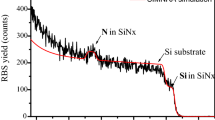Abstract
We present systematic studies of charge-carrier relaxation processes in sonochemically nanostructured silicon wafers. Impedance spectroscopy and transient photovoltage techniques are employed. It is found that interface potential in Si wafers remarkably increases upon their exposure to sonochemical treatments in Ca-rich environments. In contrast, the density of fast interface electron states remains almost unchanged. It is found that the initial photovoltage decay, taken before ultrasonic treatments, exhibits the involvement of shorter- and longer time recombination and trapping centers. The decay speeds up remarkably due to cavitation treatments, which is accompanied by a substantial quenching of the photovoltage magnitude. It is also found that, before the treatments, the photovoltage magnitude is markedly non-uniform over the wafer surface, implying the existence of distributed sites affecting distribution of photoexcited carriers. The treatments cause an overall broadening of the photovoltage distribution. Furthermore, impedance measurements monitor the progress in surface structuring relevant to several relaxation processes. We believe that sonochemical nanostructuring of silicon wafers with dendronized CaSiO3 may enable new promising avenue towards low-cost solar energy efficiency multilayered solar cell device structures.







Similar content being viewed by others
References
Angermann H (2008) Passivation of structured p-type silicon interfaces: effect of surface morphology and wet-chemical pre-treatment. Appl Surf Sci 254:8067
Baicker JA (1963) Recombination and trapping in normal and electron-irradiated silicon. Phys Rev 129:1174–1180
Baker-Finch SC, McIntosh KR, Terry ML (2012) Isotextured silicon solar cell analysis and modeling 1: optics. IEEE J Photovolt 2:457–464. https://doi.org/10.1109/JPHOTOV.2012.2206569
Bisquert J, Fabregat-Santiago F (2010) Impedance spectroscopy: a general introduction and application to dye-sensitized solar cells. CRC Press, Boca Raton
Grant DT, Catchpole KR, Weber KJ, White TP (2016) Design guidelines for perovskite/silicon 2-terminal tandem solar cells: an optical study. Opt Express 24:1454–1470
Green MA (2002) Lambertian light trapping in textured solar cells and light-emitting diodes: analytical solutions. Prog Photovolt Res Appl 10:235–241. https://doi.org/10.1002/pip.404
Horcas I et al (2007) WSxM: a software for scanning probe microscopy and a tool for nanotechnology. Rev Sci Instrum 78:013705–013705-8
Jeon NJ, Noh JH, Yang WS, Kim YC, Ryu S, Seo J, Seok SI (2015) Compositional engineering of perovskite materials for high-performance solar cells. Nature 517:476–480
Kenyon AJ et al (1996) The origin of photoluminescence from thin films of silicon-rich silica. J Appl Phys 79:9291–9300
Mandelis A (2005) Theory of space-charge layer dynamics at oxide-semiconductor interfaces under optical modulation and detection by laser photocarrier radiometry. J Appl Phys 97:083508
Munakata C (2007) Decay times of impulse surface photovoltages in p-type silicon wafers. Jpn J Appl Phys 46:6592
Nadtochiy A, Podolian A, Korotchenkov O, Schmid J, Kancsar E, Schlosser V (2011) Water-based sonochemical cleaning in the manufacturing of high-efficiency photovoltaic silicon wafers. Phys Stat Sol C8:2927–2930
Nesheva D et al (2002) Raman scattering and photoluminescence from Si nanoparticles in annealed SiOx thin films. J Appl Phys 92:4678–4683
Ni SY, Chang J, Chou L, Zhai WY (2007) Comparison of osteoblast-like cell responses to calcium silicate and tricalcium phosphate ceramics in vitro. J Biomed Mater Res B 80:174–183
Pan Y, Zuo K, Yao D, Yin J, Xin Y, Xia Y, Liang H, Zeng Y (2016) The improved mechanical properties of β-CaSiO3 bioceramics with Si3N4 addition. J Mech Behav Biomed Mater 55:120–126
Podolian A, Kozachenko V, Nadtochiy A, Borovoy N, Korotchenkov O (2010) Photovoltage transients at fullerene-metal interfaces. J Appl Phys 107:093706
Primachenko V, Snitko O (1988) Physics of the metal doped semiconductor surface. Kyiv, Naukova dumka, p 232
Rozenberg LD (1969) Sources of high-intensity ultrasound (ultrasonic technology), vol 1. Springer, Berlin, pp 223–315
Savkina RK, Smirnov AB (2010) Nitrogen incorporation into GaAs lattice as a result of the surface cavitation effect. J Phys D Appl Phys 43(42):425301–425307
Savkina RK, Smirnov AB, Kryshtab T, Kryvko A (2015) Sonosynthesis of microstructures array for semiconductor photovoltaics. Mater Sci Semicond Process 37:179–184
Savkina RK, Gudymenko AI, Kladko VP, Korchovyi AA, Nikolenko AS, Smirnov AB, Stara TR, Strelchuk VV (2016) Silicon substrate strained and structured via cavitation effect for photovoltaic and biomedical application. Nanoscale Res Lett 11:183
Savkina RK, Smirnov AB, Gudymenko AI, Morozhenko VA, Nikolenko AS, Smoliy MI, Кryshtab TG (2018) Silicon surface functionalization based on cavitation processing. Surf Coat Technol 343:17–23
Shimizu-Iwayama T, Nakao S, Saitoh K, Fujita T, Itoh N (1994) Visible photoluminescence in Si+-implanted silica glass. J Appl Phys 75:7779–7783
Yang WS, Noh JH, JeonNJ Kim YC, Ryu S, Seo J, Seok SI (2015) High-performance photovoltaic perovskite layers fabricated through intramolecular exchange. Science 348:1234–1237
Author information
Authors and Affiliations
Corresponding author
Additional information
Publisher’s Note
Springer Nature remains neutral with regard to jurisdictional claims in published maps and institutional affiliations.
Rights and permissions
About this article
Cite this article
Savkina, R., Smirnov, A., Kirilova, S. et al. Charge-carrier relaxation in sonochemically fabricated dendronized CaSiO3–SiO2–Si nanoheterostructures. Appl Nanosci 9, 1047–1056 (2019). https://doi.org/10.1007/s13204-018-0763-3
Received:
Accepted:
Published:
Issue Date:
DOI: https://doi.org/10.1007/s13204-018-0763-3




